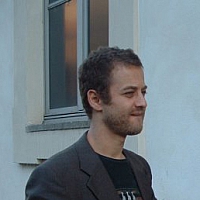
The Promenade Gallery Blvd. Cameria skele uji i ftohte L. Pavaresia 9400 Vlore Albanie
The Promenade Gallery is proud to present the project “So Many Men”, that consist in these fourworks:
We met Roye Lee in the streets of central Milan and we have listened to his voice singing and telling unbelievable stories. After 35 years lived as a clochard he has returned on stage (teatro Out-Off, Milan), alone, with his emotions and his blues and country songs. The video is a fragment showing, through gazes, gestures and lyrics, a life to the extreme, an uncontrollable energy: this is our portrait of “Roye Lee” (Alessandro Mancassola and Barbara Ceriani Basilico).
"Men Looking” is one of the images from artist's photo-reportage of Eurosatory Paris 2008, the international Army Fair. Because of security reasons the access to this event was restricted only to invited guests from the defense industry. The artists portraits the investors and the soldiers in their efforts to create a contest to present their products. Only men between men from the same field, a documentarist image of this representation of technological innovation, plans and power (Gaia Fugazza)
The video “Anema e core” represents the nucleus of this exploration. Set in a volcanic area of Iceland, the video features the volcanologist Gudmundur Eggertsson, against a desolate landscape of black rock and wind singing Anema e core, an icon of the canzone napoletana which has always been one of the great passions of this energetic Northern character. Eyes closed and earphones in, Eggertsson sings softly, apparently in a world of his own, unaware of the bleak beauty of the natural world around him. His singing seems to give him the force to withstand the violent gusts of wind that sweep the landscape and billow out his clothes (Bruno Muzzolini).
In “Selfportrait” the artist seems to be following the late Rembrandt’s track, when the lack of models left him working by himself. The room where it was shot is incredibly dark, and the same lone tiny red light allow the camera to capture the artist’s still nose, forehead and hair. The screen displays nothing but the portrait of the artist lost in the darkness suffused in red. The picture is still, with almost nothing happening. The sound is cut out of the footage. “Selfportrait” seems to be a single frame, albeit being a video-loop lasting several minutes. The strong sense of intimacy it shows is not meant to represent man’s dark side, its solitude or its sense of guilt, but the sublime moments of intimacy and reflection, the silent form of being (Fani Zguro).


